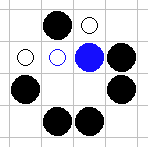Maze of Life - Active oscillators
A wonderful new feature of Intelligent-cell Life (ILife) is the active-oscillator (or flipper). Similar to standard Life oscillators, an active oscillator is a sequence of steps that creates a cycle by returning to the start-state, but here the blue-cell plays an active role.
Active oscillators are not so hard to come by, but a 7x7 play-area is rather limiting, and searching for them methodically really requires a specialised search program (as yet untackled). Yet Jacco's stable-state search program did uncover many more for the collection and, inparticular began, to find some higher-order (3+) oscillators. Find out more below or discover your own 3-step active-oscillator using the following mini-challenge.
Mini challenge
From: USS\D\UDRDRRSSLSLL>/
Find: A 3-step active oscillator
(ie. return here in 3 moves)
This challenge has been pre-loaded, just click on the grid to move the blue cell.
example active oscillator

Controls
Click on Edit to set up a start position.
Click on Play to switch to play mode or to restart.
Use Undo/redo to replay previous moves (play mode only).
Click on Load to verify and rerun the move sequence in
the text box (play mode only).
Movement
In Edit mode click on the grid to toggle cell status
(black/blue/empty).
In Play mode click on the grid to move.
Keys
u - undo last move
Findings
Here are some early examples of 2-step active oscillators (flippers) discovered by hand. All these simple oscillators consist of two states that are mirror images of each other. The red arrow indicates the required movement of the blue-cell.

Solution strings for many more active-oscillators are listed here, and the best of them are illustrated below in demo form. Just click on a link to try one. Each demo is pre-loaded with exactly two repeats of the oscillation, just use undo/redo to explore the cycle.
- Firstly the Y-start active oscillator - one of the simplest (see f3 above).
- And how about
return-to-Y?
You can do it in 22 moves.
(effectively a 22-step oscillator, although this sequence is 7x7 (edge) dependent). - Here's three more examples of nice two step oscillators: No.1 - No.2 - No.3
- Here's an interesting 4-step oscillator (edge-dependent).
- And here's a way to make it non-edge dependent.
- Here are three 3-step oscillators: No.1 - No.2 - No.3
- Finally a higher-order (6-step) non-edge based oscillator
Note that in the last case the blue-cell is stationary for 4 out of 6 moves (SSLSSR), but it is still an active oscillator since it only takes one move of the blue-cell to break the normal life sequence and create something new. If the blue-cell doesn't move at all, then you have a traditional Life oscillator. Interestingly not all traditional life oscillators are supported in ILife, I believe the general rule is that ILife can only mimic traditional oscillators if the oscillator contains a permanent (stator) cell which can contain the blue-cell for the duration of the complete cycle. If the blue-cell has to move, its transient nature will destroy the normal oscillator pattern.
The majority of high-order oscillators found so far are still edge-dependent and I am keen to find more to add to the collection. So if you find one, let me know. It is quite fun to try crafting them by hand (which is how I found this one) but I recommend you use a larger grid, such as 15x15.
So, we have shown the blue-cell can turn itself into simple (and not so simple) oscillators, but can it control its environment in more exotic way, say by moving around its environment and spawning isolated colonies of traditional life-forms in its path? To find out just how powerful the blue-cell can be read on... riding the glider.
applet - © Andrea Gilbert 2000-2002
material & challenges - Andrea, Carl Hoff, Jacco Compier

